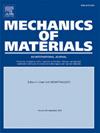Dynamic fragmentation of expanding ductile structures: Defect opening, stress release fronts and cohesive zone interactions
IF 3.4
3区 材料科学
Q2 MATERIALS SCIENCE, MULTIDISCIPLINARY
引用次数: 0
Abstract
The fragmentation of a one-dimensional expanding structure under dynamic loading conditions is analyzed, since the early work of Mott, as a competition between the activation of local defects and the inhibition of other ones by release fronts emitted when defect failure occurs. The celerity of these so-called Mott waves is computed under the assumption of immediate defect stress relaxation at failure time and it controls inhibition. However, in ductile metals, defects consist in progressively forming localized necks breaking by a process coupling plasticity and ductile failure, i.e., pore growth and coalescence. Failure is thus a non-instantaneous and dissipative process and the defect interaction problem is more complex. On the one hand, the propagation of release fronts is delayed and their celerity is a function of the effective cohesive model governing defect evolution. On the other hand, when the release fronts emitted by two neighboring defects meet as they are still opening, their subsequent evolution is driven by the interplay between the inertia of the block separating them and the evolution of the two cohesive stresses: defect unloading before complete opening occurs in some cases. The whole structure fragmentation process then involves broken, partially open (arrested necks) and inhibited defects and lead to fragment sets different from the ones predicted under the Mott assumption.
膨胀延性结构的动态破碎:缺陷开口、应力释放前沿和黏结带相互作用
从Mott的早期工作开始,分析了一维膨胀结构在动载荷条件下的破碎,认为这是局部缺陷的激活与缺陷失效时释放的释放前沿对其他缺陷的抑制之间的竞争。这些所谓的莫特波的速度是在失效时缺陷应力立即松弛的假设下计算的,它控制了抑制。然而,在延性金属中,缺陷在于通过塑性和延性破坏耦合过程(即孔隙生长和聚并)逐渐形成局部颈部断裂。因此,失效是非瞬时耗散过程,缺陷相互作用问题更为复杂。一方面,发布前沿的传播是延迟的,其速度是控制缺陷演化的有效内聚模型的函数。另一方面,当两个相邻缺陷发射的释放前沿在它们仍处于打开状态时相遇时,它们的后续演变是由分离它们的块的惯性和两个内聚应力的演变之间的相互作用驱动的:在某些情况下,缺陷在完全打开之前卸载。整个结构破碎过程包括破碎、部分打开(颈部受阻)和抑制缺陷,导致碎片集不同于莫特假设下的预测。
本文章由计算机程序翻译,如有差异,请以英文原文为准。
求助全文
约1分钟内获得全文
求助全文
来源期刊

Mechanics of Materials
工程技术-材料科学:综合
CiteScore
7.60
自引率
5.10%
发文量
243
审稿时长
46 days
期刊介绍:
Mechanics of Materials is a forum for original scientific research on the flow, fracture, and general constitutive behavior of geophysical, geotechnical and technological materials, with balanced coverage of advanced technological and natural materials, with balanced coverage of theoretical, experimental, and field investigations. Of special concern are macroscopic predictions based on microscopic models, identification of microscopic structures from limited overall macroscopic data, experimental and field results that lead to fundamental understanding of the behavior of materials, and coordinated experimental and analytical investigations that culminate in theories with predictive quality.
 求助内容:
求助内容: 应助结果提醒方式:
应助结果提醒方式:


